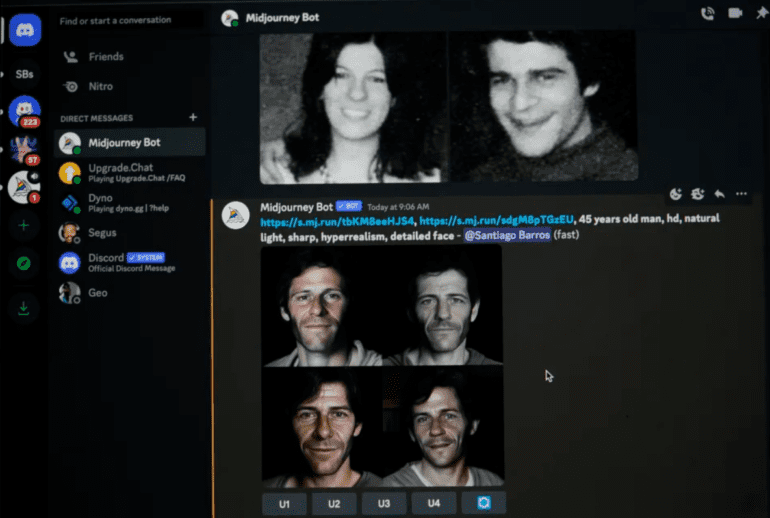TL;DR:
- Santiago Barros utilizes AI to visualize faces of children from Argentina’s military dictatorship era.
- Project aims to provide insight into appearance of missing children as adults.
- Images are shared on Instagram account “iabuelas,” blending AI with activism.
- App named Midjourney combines photos of vanished parents for realistic adult face simulations.
- Project prompts reflection among individuals over 46, encouraging self-discovery.
- Grandmothers of Plaza de Mayo appreciate the initiative, emphasize DNA testing’s role.
- Around 500 children were taken during the dictatorship; 133 have been identified by Grandmothers.
- Images spark connections among families, while some perceive tendencies toward standardization.
- AI campaign acknowledges limitations and potential biases in results.
- Grandmothers stress that AI simulations complement genetic complexity.
Main AI News:
In a poignant exploration of history’s enduring mysteries, Argentine publicist Santiago Barros spearheads an innovative project that employs artificial intelligence to visualize the faces of individuals who were torn from their parents during Argentina’s military dictatorship. Stretching back four decades, these absences have left a haunting void, compelling Barros to seek answers and give a voice to the voiceless through technological means.
Barros, driven by a deep curiosity and empathy, seeks to answer a question that has lingered in the hearts of many: What would these missing children look like today, as adults? Leveraging artificial intelligence as his creative tool, he engages in the intricate task of generating images that imagine the grown-up faces of those who were robbed of their parents during the oppressive regime.
Each day, the fruits of Barros’ labor find their way onto the digital canvas of an Instagram account, aptly named “iabuelas.” This portmanteau, an amalgamation of the Spanish words for artificial intelligence (IA) and grandmother (abuela), pays tribute to the famed Grandmothers of Plaza de Mayo—an activist collective that has ceaselessly pursued the recovery of missing children.
Barros’ mission is two-fold. Not only does he aim to visualize the possible faces of the children taken during those turbulent years, but he also seeks to spark a sense of conscience within those now aged 46 and above. Through these poignant images, Barros hopes to trigger introspection and prompt individuals to contemplate their origins, potentially leading them to seek answers and understanding.
Guided by an AI app named Midjourney, Barros employs a meticulous process to blend images of the vanished parents found in the public archives of the Grandmothers website. The resultant images stand as digital reflections of what these individuals might have looked like in adulthood. In a testament to the thoroughness of his approach, the AI presents four possibilities—two male and two female faces—out of which Barros selects the most authentic representations.
Nonetheless, Barros is clear that his endeavor does not seek to supplant the Grandmothers’ efforts in identifying grandchildren through DNA testing. Instead, it serves as a poignant reminder of the decades that have transpired since the group embarked on their relentless quest.
The Grandmothers of the Plaza de Mayo, a steadfast force in this narrative, estimate that around 500 children were snatched from their families during the harrowing dictatorship. To date, their relentless commitment has led to the identification of 133 grandchildren through genetic analysis.
Barros’ project has been met with appreciation by the Grandmothers, who view it as a vital tool for raising awareness about the plight of these missing and kidnapped children. However, they emphasize that DNA testing remains the definitive method for reuniting these individuals with their biological families.
Utilizing material from the Grandmothers’ archives and contributions from interested parties, Barros navigates the delicate path of crafting these evocative images. Some observers have noted potential tendencies towards uniformity in the images, sparking discussions about their authenticity. Yet, in certain instances, families in search of their lost loved ones have been profoundly moved by the resemblances that have emerged, offering a glimmer of connection.
For Matías Ayastuy, the endeavor hit particularly close to home. Sharing the photos of his vanished parents with Barros, he hoped to glimpse the potential appearance of a sibling. The AI algorithm ingeniously combined the likenesses of his mother and father, yielding astonishingly accurate results. Ayastuy was struck by the resemblance in the feminine image, connecting him to a long-lost cousin.
While the initial weeks of the project’s launch have yet to witness any direct cases of self-identification through the images, the impact resonates. These images are a testament to the power of technology to bridge the gaps left by time and history.
As the images find their place on the digital canvas of Instagram, a crucial disclaimer accompanies them. The project is explicitly labeled as an “unofficial artistic project,” and it underscores that the outcomes generated by AI can bear inaccuracies—a reminder of the complexities of history and identity that these images aim to address.
Barros acknowledges the nuances of the endeavor, acknowledging potential biases while highlighting the historical context of European ancestry in Argentina. This acknowledgment serves to ground the project within the cultural landscape it seeks to portray.
The grandmothers, while supportive, remain cautious about inflating expectations. They emphasize the multifaceted nature of human identity and the limitations of AI in capturing this essence. They underscore the interplay between genetics and the broader scope of an individual’s makeup.
Conclusion:
This project melds technology and empathy to envision the faces of missing children from Argentina’s history. While shedding light on the past, it also highlights the importance of DNA testing for accurate identification. The endeavor signifies the integration of AI into historical narratives, showcasing the potential for technology to stimulate reflection and connection in the modern world.

